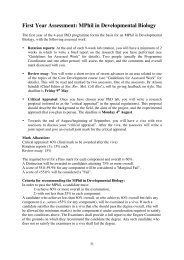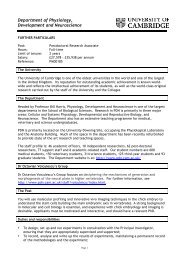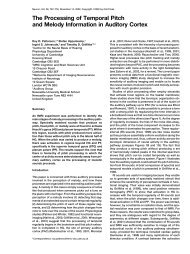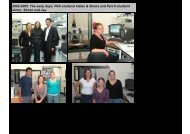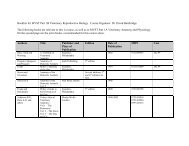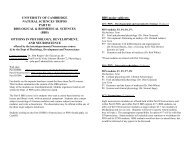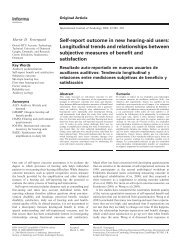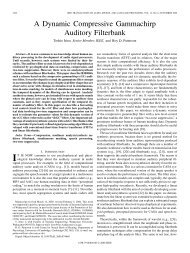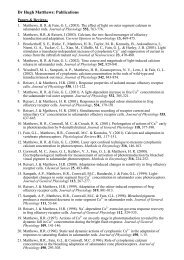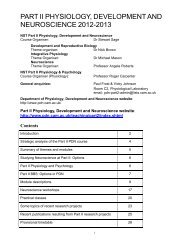FRIDAY MORNING, 20 MAY 2005 REGENCY E, 8:30 A.M. TO 12:00 ...
FRIDAY MORNING, 20 MAY 2005 REGENCY E, 8:30 A.M. TO 12:00 ...
FRIDAY MORNING, 20 MAY 2005 REGENCY E, 8:30 A.M. TO 12:00 ...
You also want an ePaper? Increase the reach of your titles
YUMPU automatically turns print PDFs into web optimized ePapers that Google loves.
ployees and customers were measured and compared to maximum permitted<br />
occupational limits. Worker noise exposures were in the range 80–84<br />
dBA. Customers were often exposed to levels over 75 dBA; especially at<br />
lunchtime it exceeded 80 dBA. The CATT room-acoustical prediction<br />
model was used to study the physical and acoustical factors that affect the<br />
acoustical environments in eating establishments and how optimize them.<br />
The effect of facility modifications, including the use of sound-absorbing<br />
wall panels, lowered and improved acoustical ceilings, and partial barriers<br />
between tables were predicted.<br />
9:45<br />
5aAA6. A new method for measuring the speech security of meeting<br />
rooms. John S. Bradley and Bradford N. Gover Inst. for Res. in<br />
Construction, Natl. Res. Council, Montreal Rd., Ottawa, Canada K1A<br />
0R6<br />
This paper describes a proposed new method for measuring the speech<br />
security of offices and meeting rooms. It is intended to assess the risk of<br />
someone who is talking in the meeting room being overheard at points<br />
outside the room, close to the outside boundaries of the room. Previous<br />
work has derived frequency-weighted speech-to-noise type measures that<br />
are well related to the perceived intelligibility and audibility of the transmitted<br />
speech. The proposed new method measures the attenuation between<br />
average levels in the meeting room and received levels at points<br />
0.25 m from the outside boundaries of the meeting room in adjacent<br />
spaces. The average source room levels are representative of all possible<br />
talker location. The receiving points, 0.25 m from the room boundaries,<br />
can assess expected privacy at critical listening locations with minimal<br />
effect of the acoustical properties of the adjacent spaces. New measurements<br />
in 11 meeting rooms have been used to evaluate the influence of<br />
several parameters on the accuracy of the measured degree of speech<br />
security. These include: the type and number of sound sources used, and<br />
the number and location of microphones in the meeting room and the<br />
adjacent spaces. Details of the analyses will be presented.<br />
10:<strong>00</strong>–10:15 Break<br />
10:15<br />
5aAA7. A simplified method to estimate the free path length variance.<br />
Yan Zhang, Godfried Augenbroe, Ruchi Choudhary College of<br />
Architecture, and Brani Vidakovic Georgia Inst. of Technol., Atlanta,<br />
GA <strong>30</strong>332<br />
Kutruff derived an analytical solution for the prediction of reverberation<br />
time in spaces with arbitrary shape. It is the most popular analytical<br />
equation that contains shape factors. However, in this equation the free<br />
path length variance remains as unknown parameter. Kutruff suggested the<br />
implementation of Monte-Carlo simulation to determine this value for<br />
each unique shape. In practice this method is not significantly simpler than<br />
a full ray tracing simulation. Fortunately, using methods from the probability<br />
field, the free path length variance does have an analytical solution,<br />
but this takes such a complicated form that it is not convenient to use. This<br />
article treats the development of a simplified method to estimate the free<br />
path length variance without losing accuracy when applied to concert<br />
halls. A simplified regression model is developed for rectangular shapes<br />
based on the analytical solution. This simple model explains 99.8% variance<br />
for any rectangular shape up to 1:10:10. Secondly, for arbitrary<br />
shapes, a simplified model is proposed by including several additional<br />
simple variables. This model is validated against simulation results. It will<br />
be shown that this simplified method not only can be used in Kutruff’s<br />
equation, but also reveals the significant shape-related parameters that<br />
influence the reverberation time.<br />
10:<strong>30</strong><br />
5aAA8. Acoustic modeling in rectangular rooms with impedance<br />
using the finite element method with the Dirichlet-to-Neumann map.<br />
Yusuke Naka Dept. of Aerosp. and Mech. Eng., Boston Univ., 677<br />
Beacon St., Boston, MA 02215, ynaka@bu.edu, Assad A. Oberai and<br />
Barbara G. Shinn-Cunningham Boston Univ., Boston, MA 02215<br />
Computational models of head-related transfer functions HRTFs are<br />
useful in investigating the effects of echoes and reverberations in enclosures.<br />
These models may be computed at relatively low cost by geometric<br />
methods, such as the image source method. However, geometric methods<br />
typically ignore several important physical effects, such as diffraction,<br />
which effect the fidelity of the resulting HRTF. On the other hand, methods<br />
based on solving the wave equation, such as the finite element method,<br />
include these effects but tend to be computationally expensive. This study<br />
represents a Dirichlet-to-Neumann DtN map which significantly reduces<br />
the costs associated with using the the finite element method for computing<br />
HRTFs in a rectangular room, by analytically eliminating empty regions<br />
of the room. The DtN map for rooms with realistic impedance<br />
boundary conditions is developed. This work represents an extension of<br />
our previous approach for sound-hard rooms Y. Naka, A.A. Oberai, and<br />
B.G. Shinn-Cunningham, Proc. 18th International Congress on Acoustics,<br />
Vol. IV, pp. 2477–2480 <strong>20</strong>04. Work supported by AFOSR.<br />
10:45<br />
5aAA9. Analysis of diffuse broadband sound fields in enclosures by<br />
decomposition in powers of an absorption parameter. Donald B.<br />
Bliss, Jerry W. Rouse, and Linda P. Franzoni Mech. Eng. and Mater. Sci.,<br />
Duke Univ., Durham, NC 27708, dbb@duke.edu<br />
A novel analysis for steady-state or time-dependent broadband diffuse<br />
sound fields in enclosures is developed. Beginning with a formulation<br />
utilizing broadband intensity boundary sources, the strength of these wall<br />
sources is expanded in a series in powers of an absorption parameter,<br />
thereby giving a separate boundary integral problem for each power. The<br />
first problem has a uniform interior field level proportional to the reciprocal<br />
of the absorption parameter, as expected. The second problem gives a<br />
mean-square pressure distribution that is independent of the absorption<br />
parameter and is primarily responsible for the spatial variation of the reverberant<br />
field. This problem depends on the location of sources and the<br />
spatial distribution of absorption, but not absorption level. Additional<br />
problems proceed at integer powers of the absorption parameter, but are<br />
essentially higher order corrections to the spatial variation. The important<br />
second problem and the higher order problems are easily solved numerically,<br />
but closed form approximate solutions based on one iteration step<br />
are simple and accurate. Solutions obtained by retaining only the first<br />
couple of terms in the series expansion are compared to complete solutions<br />
obtained by another approach, and good agreement is shown between<br />
the two methods.<br />
11:<strong>00</strong><br />
5aAA10. Finite-sized sources in the presence of boundaries. John R.<br />
MacGillivray Red Tail Hawk Corp., 111 E. Seneca St., Ithaca, NY<br />
14850 and Victor W. Sparrow Penn State, University Park, PA 16802<br />
Many methods of auralization convolve a source signal e.g., cello<br />
recorded in an anechoic room with a room’s impulse response which has<br />
been computed using method of images, ray tracing, etc.. Many instruments<br />
are finite-sized sources because they produce music having frequencies<br />
where the product of the wavenumber and the instrument’s characteristic<br />
length is not small. Sound produced by a finite-sized source in the<br />
presence of boundaries can include scattering and diffraction, resulting<br />
from the presence of the source in its own field. These effects are not<br />
accounted for by the auralization types mentioned above. A geometrically<br />
simple example of a finite-sized pulsating sphere in the presence of a rigid<br />
infinite boundary is solved using the translational addition theorem for<br />
spherical wave functions TATSWF. Using TATSWF, the original problem<br />
is solved by replacing the rigid infinite wall with an image of the<br />
finite-sized sphere. This is a surprisingly complicated problem to solve,<br />
2580 J. Acoust. Soc. Am., Vol. 117, No. 4, Pt. 2, April <strong>20</strong>05 149th Meeting: Acoustical Society of America 2580



